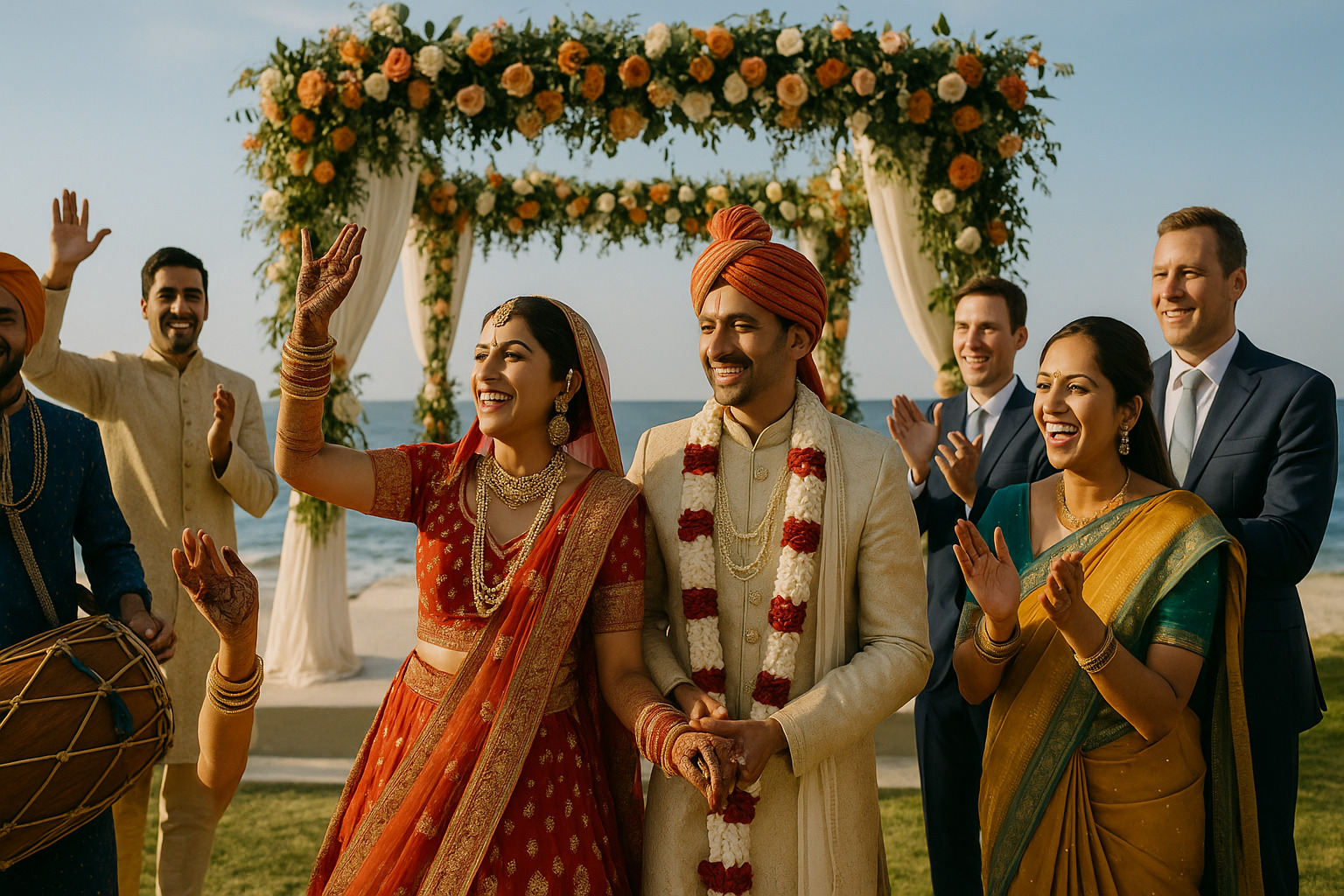
Do Desi weddings change when they move abroad? Or do they simply grow louder, brighter, and more layered? As Indian culture travels far beyond its borders, weddings become cultural passports—mixing tradition with geography, ritual with reinterpretation, and celebration with diplomacy.
Whether in Dubai or Dallas, Sydney or Singapore, Desi weddings retain their rhythm but gain accents. They evolve—not by shedding roots but by branching into new soil.
The Global Stage for a Homegrown Spectacle
Indian weddings are now being celebrated across continents, with countries like the United States, Canada, the UK, UAE, Australia, and Singapore witnessing an uptick in elaborate Desi nuptials. These ceremonies serve not only as personal milestones but also as displays of cultural continuity and community identity.
Diaspora families often go beyond mere nostalgia. Weddings are intentional platforms to express pride, history, and inclusivity. This often results in six-day itineraries that blend temple rituals with rooftop sangeets and poolside mehndis with multicultural guest lists.
What Stays: Non-Negotiables Across Borders
No matter the location, some wedding elements rarely shift:
- Rituals: Whether North Indian or South Indian, Hindu, Sikh, Muslim, or Christian, core ceremonies stay intact. The pheras, nikah, or mangalsutra moments are honored with full reverence.
- Family Hierarchy: Elders take center stage in planning, seating, introductions, and decision-making, reinforcing lineage and respect.
- Food: The menu is often as sacred as the vows. Whether catered in London or cooked by aunties in Kuala Lumpur, the flavors—biryani, dal makhani, gulab jamun—carry ancestral weight.
What Adapts: Form, Space, and Identity
Weddings abroad don’t replicate India. They reframe it.
1. Venues with a Local Twist
Banquet halls become palaces. Vineyards become havens of haldi. Private islands see mandaps erected between palm trees. In cities like Tokyo or Toronto, couples often pick venues that echo both their roots and their current world.
2. Timing Adjustments
Weekends, work calendars, and immigration paperwork play roles. A four-day wedding might be condensed to a power-packed weekend. Jet lag? It’s now part of the agenda.
3. Intercultural Guest Lists
From Irish groomsmen learning bhangra to Japanese aunties tying the bride’s chooda, cultural exchange becomes a built-in feature. Cue translations, welcome cards in multiple languages, and a growing trend of bilingual priests and emcees.
Fashion: Silk Meets Sequins, Saree Meets Structure
The bride might wear a red lehenga for the ceremony and a white gown for the reception. The groom might switch from sherwani to tux. Guests show up in kurta-pajamas one day and cocktail dresses the next.
Designers have taken note. Outfits are now lighter, flight-friendly, and fusion-aware. Think mirror work jackets over tailored pants, or kanjivaram-inspired gowns.
Trending Bridal Looks Abroad:
- Pre-draped sarees with corset blouses
- Floral haldi outfits with sneakers
- Dupatta veils attached to buns with Swarovski pins
- Mehndi-friendly rompers for dance events
Soundtracks of Identity
Bollywood still rules the dance floor, but global beats are making inroads. DJs mix Punjabi tracks with reggaeton, house with Garba, and Tamil kuthu with techno. Even playlists now carry cross-cultural signatures.
Live performances from multicultural artists—tabla players in Berlin, dhol groups in New York—underscore the musical hybridization.
Destination Weddings: Culture on the Move
Destination weddings aren’t just about scenic backdrops. They’re testaments to how families are willing to travel with their traditions—literally. Whether it’s a Rajasthani theme in Greece or a Tamil wedding in Kyoto, logistics become extensions of devotion.
Top Global Spots for Desi Weddings:
- Bali: Blends spiritual calm with ornate backdrops.
- Dubai: Known for scale, accessibility, and luxury hospitality.
- Portugal: Popular for Goan Catholic ceremonies.
- Mexico: Chosen for affordability and visa ease for guests.
The Fusion of Food: Chaat to Cheese Boards
Food stations now feature dosas next to dim sum, samosas beside sushi. Signature cocktails get an Indian twist—think chai martinis or paan mojitos.
Caterers abroad specialize in meeting cross-generational and cross-cultural expectations. A menu might include Jain options, gluten-free picks, halal preparations, and modern interpretations like butter chicken sliders.
Tech and Social Media: Digital Rituals
With many relatives unable to travel, live-streaming has become standard. QR code RSVPs, wedding websites, and virtual ceremonies now sit side-by-side with dhol entrances and floral varmala exchanges.
Hashtags often double as memory albums: #ShaadiInSeoul, #FromDelhiToDallas, #TwoStatesAcrossOceans.
Emotional Continuity, Global Backdrops
Despite all changes, the emotional tone remains rooted: union, legacy, laughter, and sentiment. Grandparents bless, siblings tease, and cousins organize flash mobs. The rituals remain heartfelt, the tears still real.
Even as new cultural notes are added, the emotional base note holds strong: weddings remain both a passage and a performance.
Key Takeaways for Planning a Desi Wedding Overseas
- Start planning early: Visas, venues, and vendors require more time abroad.
- Blend, don’t dilute: Traditions adapt best when explained, not omitted.
- Hire bilingual vendors: Translators, priests, and planners who understand both cultures avoid mishaps.
- Create buffers: For time zones, jet lag, and last-minute imports.
- Involve locals: Add one ritual or experience that honors the host country.
Indian weddings abroad are more than just events. They are statements—of continuity, of transformation, and of cultural pride stitched across borders. The sari and the champagne flute aren’t at odds. They’re sharing a dance floor.

